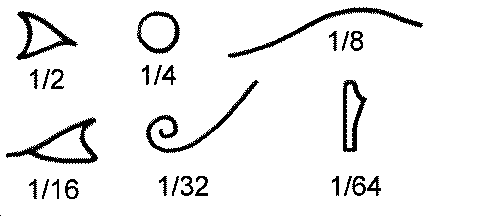The oldest papyrus scrolls from ancient Egypt describe mathematics. Especially important to the ancient Egyptians were fractions. Every conceivable fraction can be expressed as the sum of reciprocals (fractions that are 1/n), and they had a couple of good reasons for using these sums, nowadays known as Egyptian fractions.
Firstly, it made comparisons easier. To work out which is the larger of 3/4 and 4/5, with Egyptian Fractions you get the answer and the margin:
3/4 = 1/2 + 1/4
4/5 = 1/2 + 1/4 + 1/20
We can now see that 4/5 is the larger – by exactly 1/20
Secondly, how would you share 5 sacks of grain between 8 people? Yes, they get 5/8 of a sack each, but that isn’t easy to actually measure out. So using Egyptian fractions we get this answer:
5/8 = 1/2 + 1/8
That’s 1/2 a sack each, plus 1/8 of a sack each. Much easier to actually measure!
The above examples, useful calculators and more, are at Dr Ron Knott’s site:
http://www.maths.surrey.ac.uk/hosted-sites/R.Knott/Fractions/egyptian.html
This image is from Terrance Nevin’s site, feels legit:
It is becoming clear to me that ancient dimensions are based on ratios. As a poor example, 22/7 = pi. Pyramids that have seemingly random angles fit in nicely when the ratio is unveiled.
While we have some commonalities – the great pyramid of Giza is twice the height and the same base of the Pyramid of the Sun in Mexico – most of the found ratios tend to have isolated numerical qualities.
Perhaps, back then, the only important factor was that the dimensions of your building fitted a ratio. Any ratio. Perhaps society back then just looked for ratios?
This makes sense if you consider the wheel to be a ratio, or the lunar eclipse cycle….
—-
Of late I am thinking that the ancient mysterious elders were missionaries. Dropped off in remote lands, and leaving decades later.

